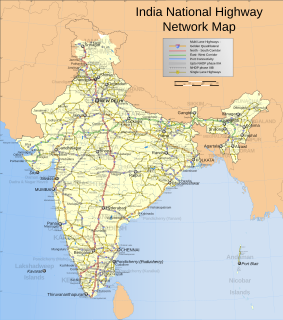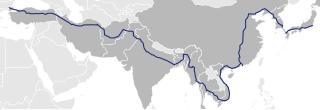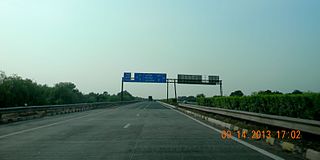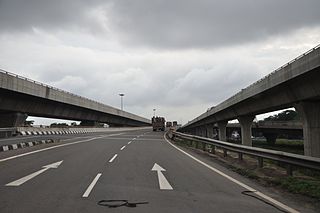
The South Luzon Expressway (SLEX), signed as E2 of the Philippine expressway network and R-3 of the Metro Manila arterial road network, is a limited-access toll expressway that connects Metro Manila to the provinces in the Calabarzon region on the island of Luzon in the Philippines. The expressway has a length of 46.9 km, traveling from its northern terminus at the Magallanes Interchange to its southern terminus at Santo Tomas, Batangas, connecting it to the Southern Tagalog Arterial Road. A portion of the expressway from the Magallanes Interchange to the Calamba Exit is part of Asian Highway 26 of the Asian highway network.

The expressway network of China, with the national-level expressway system officially known as the National Trunk Highway System, is an integrated system of national and provincial-level expressways in China.

A limited-access road, known by various terms worldwide, including limited-access highway, dual-carriageway, expressway, and partial controlled access highway, is a highway or arterial road for high-speed traffic which has many or most characteristics of a controlled-access highway, including limited or no access to adjacent property, some degree of separation of opposing traffic flow, use of grade separated interchanges to some extent, prohibition of some modes of transport such as bicycles or horses, and very few or no intersecting cross-streets or level crossings. The degree of isolation from local traffic allowed varies between countries and regions. The precise definition of these terms varies by jurisdiction.

The expressways of Japan make up a large network of controlled-access toll expressways.

The Mumbai–Pune Expressway is India's first 6-lane wide concrete, access-controlled tolled expressway. It spans a distance of 94.5 km connecting Mumbai, the capital of Maharashtra state and the financial capital of India, with Pune, the cultural and educational capital of Maharashtra. The expressway, which was fully operationalized in 2002, introduced new levels of speed and safety in automobile transportation to Indian roads. It is one of India's busiest roads.

A controlled-access highway is a type of highway that has been designed for high-speed vehicular traffic, with all traffic flow—ingress and egress—regulated. Common English terms are freeway, motorway and expressway. Other similar terms include throughway and parkway. Some of these may be limited-access highways, although this term can also refer to a class of highway with somewhat less isolation from other traffic.

Roads are an important mode of transport in India. India has a network of over 6,215,797 kilometres (3,862,317 mi) of roads as of 31 March 2020. This is the second-largest road network in the world, after the United States with 6,853,024 kilometres (4,258,272 mi). At of roads per square kilometre of land, the quantitative density of India's road network is equal to that of Hong Kong, and substantially higher than the United States, China, Brazil and Russia. Adjusted for its large population, India has approximately 5.13 kilometres (3.19 mi) of roads per 1,000 people, which is much lower than Unites States 20.5 kilometres (12.7 mi) but higher than that of China 3.6 kilometres (2.2 mi). India's road network carries over 71 percent of its freight and about 85 percent of passenger traffic.

Asian Highway 1 (AH1) is the longest route of the Asian Highway Network, running 20,557 km (12,774 mi) from Tokyo, Japan via Korea, China, Southeast Asia, Bangladesh, India, Pakistan, Afghanistan and Iran to the border between Turkey and Bulgaria west of Istanbul where it joins end-on with European route E80, running all the way to Lisbon, Portugal.
The Bayshore Route signed as Route B, is one of the routes of the tolled Shuto Expressway system in the Greater Tokyo Area. The Bayshore Route is a 62.1-kilometer (38.6 mi) stretch of toll highway that runs from the Kanazawa ward of Yokohama in the west, northeast to the city of Ichikawa in Chiba Prefecture in the east. Opened in phases beginning in 1976 and ending in 2001, it is an important route that runs between the artificial islands lining the western shore of Tokyo Bay by way of bridges and sub-sea tunnels that bypass central Tokyo.

The Western Peripheral Expressway (WPE) or Kundli–Manesar–Palwal Expressway, is an operational 6-lane, 135.6 km (84.3 mi)-long Expressway in the Haryana state of India. Along with the Eastern Peripheral Expressway, the Western Peripheral Expressway is expected to divert more than 50,000 heavy vehicles away from Delhi, which will help to maintain good air quality in Delhi. Western Peripheral Expressway along with Eastern Peripheral Expressway completes the largest Ring Road around Delhi. Each of the 10 entries and exits are tolled. Toll rate notified in December 2018 is INR1.35 per km for cars, INR2.18 per km for light motor vehicles, INR4.98 per km for trucks and buses, and two wheelers are not permitted on the expressway.

Yamuna Expressway or Taj Expressway is a 6-lane wide and 165.5 km long access-controlled expressway, connecting Pari Chowk in Greater Noida with Kuberpur on NH-2 in Agra in the Indian state of Uttar Pradesh. It is presently India's 3rd longest expressway since February 2017. It was built to de-congest the older Delhi–Agra national highway (NH-2) or Mathura Road.

Expressways are the highest class of roads in India. In India, expressways are controlled-access highways where entrance and exits are controlled by the use of ramps that are incorporated into the design of the expressway, whereas National highways are at-grade roads. Some roads are not access-controlled expressway, but are still officially called expressways, such as the Biju Expressway and Raipur–Bilaspur Expressway.
The Eastern Peripheral Expressway (EPE) or Kundli–Ghaziabad–Palwal Expressway is a 135 km (84 mi) long, 6-lane wide expressway passing through the states of Haryana and Uttar Pradesh in India. The expressway starts from the Western Peripheral Expressway at Kundli, Sonipat, passing through Baghpat, Ghaziabad and Noida districts in UP and Faridabad district in Haryana before rejoining the Western Peripheral Expressway near Dholagarh, Palwal. Eastern Peripheral Expressway along with Western Peripheral Expressway completes the largest Ring Road around Delhi. The Eastern Peripheral Expressway was declared as National Expressway 2 (NE-2) in March 2006.

The Ahmedabad Vadodara Expressway or Mahatma Gandhi Expressway or National Expressway 1 is an expressway connecting the cities of Ahmedabad and Vadodara in the state of Gujarat, India. The 93.1 km (57.8 mi) long expressway reduces the travel time between the two cities from two and a half hours to an hour. It was declared as National Expressway 1 in 1986.

Belghoria Expressway is a four-lane 16 kilometres (9.9 mi) long access controlled tolled expressway in the North Suburban fringes of Kolkata, West Bengal. It is a key arterial road, linking the terminal junction points of NH 16 and NH 19 at Rajchandrapur to Dakshineswar across Nivedita Setu and then to NH 12 at Dumdum/Kolkata Airport. Belghoria Expressway is part of AH 1.

The Malaysian Expressway System is a network of national controlled-access expressways in Malaysia that forms the primary backbone network of Malaysian national highways. The network begins with the North–South Expressway (NSE), and is being substantially developed. Malaysian expressways are built by private companies under the supervision of the government highway authority, Malaysian Highway Authority.

The Agra–Lucknow Expressway is a 302 km long, 6-lane wide access-controlled expressway constructed by the Uttar Pradesh Expressways Industrial Development Authority (UPEIDA) to reduce traffic in already congested roads and to reduce pollution and carbon footprint. The expressway reduced the distance between the cities of Agra and Lucknow in the Indian state of Uttar Pradesh and is presently India's longest operational expressway since February 2017.

Delhi–Meerut Expressway or National Expressway 3 (Hindi: दिल्ली-मेरठ एक्सप्रेसवे) is India's widest 96 km long controlled-access expressway, connecting Delhi with Meerut via Dasna in Ghaziabad in India. The 8 lanes old stretch of National Highway 9 (NH-9) up to Dasna is widened to 14 lanes(widest expressway in India). The fourth phase of the expressway is built on a new alignment from Dasna to Meerut – a six-lane stretch joining Meerut bypass. The 28 km (17 mi) stretch between Nizamuddin Bridge and Dasna is one of the most congested areas in the NCR.The total project cost is estimated to be between ₹8,000–10,000 crores.

Purvanchal Expressway is a 340.8 km long, 6-lane wide access-controlled expressway in the state of Uttar Pradesh, India. The expressway connects Chand Saray village near Gosainganj in Lucknow district with Haydaria village on NH-31 in Ghazipur district. It is developed by the Uttar Pradesh Expressways Industrial Development Authority (UPEIDA). The Purvanchal Expressway has a 3.2 km long airstrip at Akhalkiri Karwat village near Kurebhar in Sultanpur district for emergency landing of aircraft. The construction work was started by the UPEIDA on 10 October 2018 and was inaugurated and opened to public on 16 November 2021.

The Philippine expressway network, also known as the High Standard Highway Network, is a controlled-access highway network managed by the Department of Public Works and Highways (DPWH) which consists of all expressways and regional high standard highways in the Philippines.


















